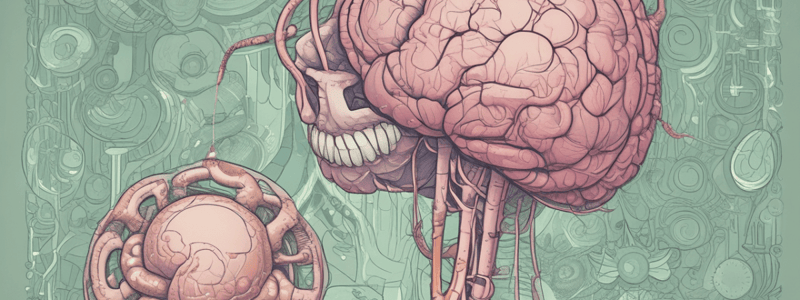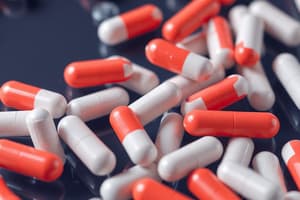Podcast
Questions and Answers
Which hormone is primarily produced by the adrenal medulla?
Which hormone is primarily produced by the adrenal medulla?
- Dopamine
- Norepinephrine
- Epinephrine (correct)
- Serotonin
What stimulates the release of catecholamines from the adrenal medulla?
What stimulates the release of catecholamines from the adrenal medulla?
- Low catecholamine levels (correct)
- High stress levels
- Increased physical activity
- Elevated catecholamine levels
Which amino acid is the precursor for the synthesis of catecholamines in the adrenal medulla?
Which amino acid is the precursor for the synthesis of catecholamines in the adrenal medulla?
- Tryptophan
- Phenylalanine
- Glutamine
- Tyrosine (correct)
Where are chromaffin cells (pheochromocytes) that synthesize catecholamines located?
Where are chromaffin cells (pheochromocytes) that synthesize catecholamines located?
Which tissue type mainly produces norepinephrine instead of epinephrine?
Which tissue type mainly produces norepinephrine instead of epinephrine?
How do catecholamines produced by the adrenal medulla primarily act on other tissues?
How do catecholamines produced by the adrenal medulla primarily act on other tissues?
Study Notes
Adrenal Medulla and Catecholamines
- The adrenal medulla is considered a neuro-endocrine unit, as it is part of the sympathetic nervous system and produces catecholamine hormones.
- The catecholamine hormones produced by the adrenal medulla are dopamine, norepinephrine, and epinephrine.
Control of Catecholamines
- The release of catecholamines from the adrenal medulla is stimulated by low levels of catecholamines in the body.
- Elevated levels of catecholamines in the body inhibit the release of catecholamines from the adrenal medulla.
Biosynthesis of Catecholamines
- Catecholamines are synthesized from the amino acid tyrosine by chromaffin cells (pheochromocytes) in the adrenal medulla.
- Chromaffin cells are also found in extramedullary tissues such as the heart, liver, kidney, gonads, sympathetic fibers, and CNS.
- The main differences between catecholamines produced by the adrenal medulla and those produced by extramedullary tissues are:
- Epinephrine is the main product of the adrenal medulla, while norepinephrine is the main product of extramedullary tissues.
- Catecholamines produced by the adrenal medulla are transported by blood circulation to act on other tissues, while those produced by extramedullary tissues act locally.
- The sequential steps for converting tyrosine into epinephrine are:
- Ring hydroxylation.
Studying That Suits You
Use AI to generate personalized quizzes and flashcards to suit your learning preferences.
Description
Learn about the adrenal medulla, a neuro-endocrine unit that produces catecholamine hormones, and how their release is controlled in the body.




